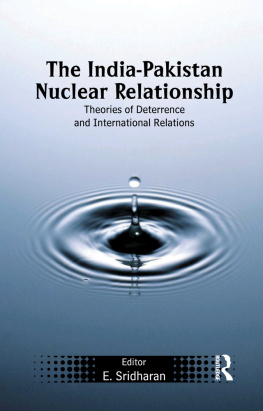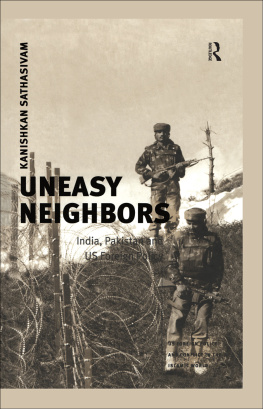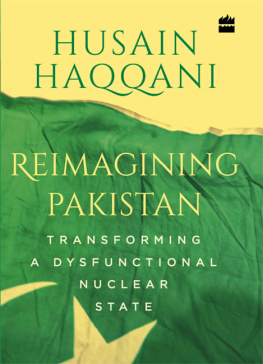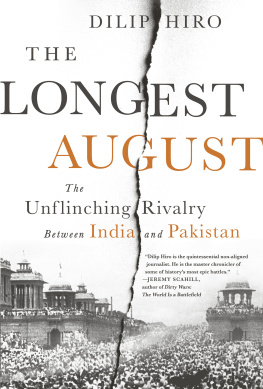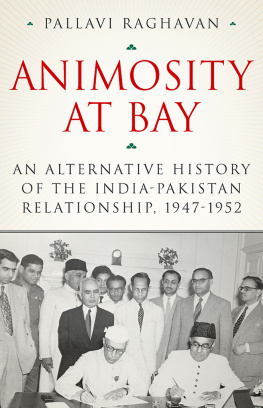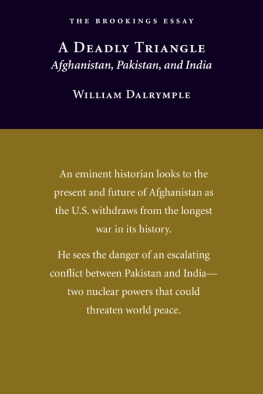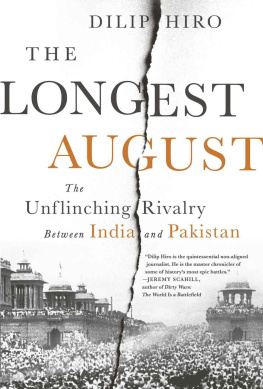Table of Contents
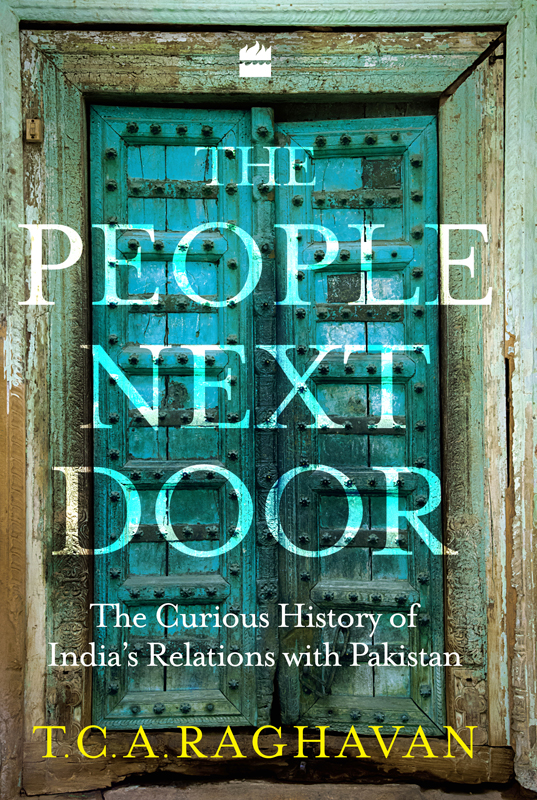
THE PEOPLE NEXT DOOR
The Curious History of
Indias Relations with Pakistan
T.C.A. Raghavan

HarperCollins Publishers India
For
Ranjana Sengupta
Contents
WHEN HARPERCOLLINS APPROACHED ME to write a history of IndiaPakistan engagement for the seventieth anniversary of our Independence, I accepted the commission with some trepidation. Books on different aspects of IndiaPakistan relations will easily fill a library. Issues and themes such as the overhang of Partition, terrorism, Kashmir in its different ramifications, sharing of river waters, the 1948, 1965, 1971 and 1998 conflicts and many others have been dealt with in detail many times over and each of these subjects now is perhaps a specialization in itself. Near-conflict situations198687, 1990, 200102, 2008 09, amongst othersare similarly the subjects of both research and speculation. Strategic, military and nuclear-related issues form advanced specializations with a large and ever-growing literature. In general, every facet of the relationship has over the decades been scrutinized and commented upon in detail and contemporary events and developments are examined and discussed with knowledge, precision and, of course, passion. Public knowledge about the relationship is considerable. Therefore, the question before me was how much more can possibly be written about a relationship which has been bad in most conceivable ways over the past seven decades.
On the other hand, my own experience of both living in Pakistan and dealing with Indias relations with Pakistan had been marked by a near-constant discovery of something new about the past. This was not so much new in terms of factual knowledge as in encountering sentiments and experiences of others who have interfaced with IndiaPakistan relations and the connections they have drawn between different events and processes. This, at least for me, often nuanced the known facts and gave a more rounded perspective on viewing an event or set of events. I thought, therefore, of illustrating, to the extent possible, the mainstream chronology of this relationship with these aspects to impart a fuller sense of how and why things developed as they did over the years. So, this is an attempt at writing an animated and anecdotal history with an aim to convey a feel of the relationship at different points of time of its past with all its oddities and curiosities. If nothing else such a treatment may, I feel, make this deeply troubled relationship more accessible and perhaps in the process also help in demystifying it.
In giving a historical overview of how and why IndiaPakistan history took the course it did, naturally I also take a great deal of knowledge of this history for granted. Hence, I pass rapidly over seminal and important persons, events and periods while dwelling, perhaps excessively, on others. I also have kept a narrow focus on the broad mainstream of the relationship itself. There are, therefore, many important aspects I am cursory with and leave aside for more specialized reading or study. This includes, for instance, the international context of IndiaPakistan relations including, in the early years, Kashmir in the United Nations, third-country relationships important for both countries and how they impacted IndiaPakistan relationsthe United States of America, China, Afghanistan, the Soviet Union/Russia, and othersthe military history of the different wars, internal developments in India and Pakistan and the changing strategic and military balance between the two. Similarly, I am cursory with IndiaEast Pakistan contestations on numerous issuesriver water sharing, land boundary demarcation, etc.
In brief, to keep the book to a manageable length, I have discarded trying to be exhaustive. My aim is to bring out a fuller flavour of IndiaPakistan relations in terms of a more subjective and selective view of both well- and lesser-known incidents and individuals in the broad context of the principal ups and downs of the relationship. The individuals I have found interesting are from a range of backgroundsprofessional diplomats, practising politicians, journalists, academics, writers, peace activists and others. They found themselves in the quirky matrix of IndiaPakistan relations and sought to navigate through it with multiple motives and objectives. To me their reflections and reactions provide a point of entry into the curious universe of the IndiaPakistan relationship at different points of time.
I have generally followed a mainstream chronology. The first and second chapters deal with the years from 1947 to 1960 and the third and fourth take the story up to December 1971 and the break-up of Pakistan. The fifth, sixth and seventh chapters cover respectively the periods 197279, 198089 and 199099. The eighth attempts to bring the story up to 2008. The reasons for this division are evident enough and I hope will become clearer in the book itself.
I must set out at the beginning two other provisos. This is a history book and not a policy book. In tracing out this history, I do not draw any grand lessons and if there are any takeaways or policy recommendations I leave it to the readers to decipher and extract if they so wish. Secondly, as we come closer to our own times I close the story somewhat abruptly. In my view, the past always needs to incubate before its history can be attempted.
Finally, while I have tried to be even-handed in covering different issues and situations, this is, needless to say, an Indian perspective on a divisive and deeply contested past and present.
BETWEEN AUGUST 1947 AND September 1948 most trends and issues which comprise the current IndiaPakistan matrix fell into place.
From JuneJuly 1947 to January 1948 the bulk of the ethnic cleansing in East and West Punjab was completed. Some twelve million refugees had traversed in both directions of the newly plotted part of the Radcliffe Line that divided and defined the newly emerged countries in Punjab. Thus, East Punjab, now falling in India, was largely emptied of Muslims and West Punjab, in Pakistan, of Hindus and Sikhs. The uprooting of Hindus, Muslims and Sikhs was systematic: houses occupied, farms taken over, mosques, temples and gurdwaras desecrated, tens of thousands killed and women targeted for rape and abduction.
This was a demographic upheaval to match the one that had just come to an end in Europe over the territory of Germany, Poland, Hungary and Czechoslovakia. In Europe, although the war had ended in 1945, large-scale displacement and violence had not. What the Poles, Hungarians and the Czechoslovaks did after the World War II with Soviet and Allied (the US, France, the UK) concurrence to the Germans of Europe, the Hindus and Sikhs did to Muslims in East Punjab and the Muslims in West Punjab to Hindus and Sikhs. The magnitude of these population transfers is also similarabout twelve million in both cases of those permanently expelled and with hundreds of thousands killed. But there were differences. In Europe, the movement was largely in one direction: Germans being forcibly moved westwards into a truncated Germany; between East and West Punjab, and elsewhere on a smaller scale, people moved in both directions across the Radcliffe Line. Secondly, in Europe there was a strong policy element inbuilt into this exercise. At Yalta and Potsdam in February and July 1945 respectively, the victorious powers had decided that Europes nations, to avoid a repetition of the two world wars, had to be made ethnically homogeneous. So, ethnic Germans in Poland, Hungary and Czechoslovakia were driven out to Germany. Germany was at the same time cut down as its borders shrank significantly to what it is today.


